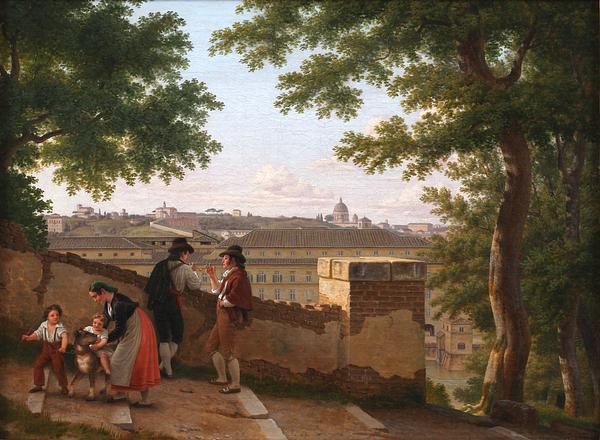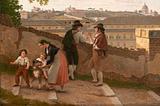Eckersberg left Rome in 1816 after having spent three years in the city. Upon arriving in Copenhagen in August 1816, he was soon busy teaching at the Royal Danish Academy of Fine Arts and executing commissioned portraits. He also continued to create Roman prospects. Often, these were near-identical versions of works he had painted in Rome. However, Eckersberg also created new compositions based on the drawings he had done in Rome, and which remained in his possession until his death.
[1] One such painting is
Prospect from Monte Aventino, which, along with its counterpart,
Prospect from Villa Casale with SS. Giovanni e Paolo (
18/1969), was executed several years after his return to Denmark.
Eckersberg found this subject on Monte Aventino, the southernmost of Rome's seven hills. He chose a point of view where the wall and the solid brick plinth block the view of the port of Porto di Ripa Grande, which lies below the yellow buildings of the Ospizio di. S. Michele, which extend throughout the picture. However, we can just make out the Tiber at the bottom right. Although the architecture of Rome is delegated to the background, the view of the city is nevertheless of great importance. In a very atypical move for Eckersberg, he has here painted one of Rome’s main landmarks, the dome of St. Peter’s Basilica. The reason may be that the painting had to live up to the expectations held by discerning, affluent Danish audiences who preferred pictures that corresponded to their ingrained ideas about Rome.
In the foreground of the painting, a couple of men can be seen conversing by the wall of the stepped road while a woman passes by with her two children, one of whom is riding a dog. The charming, everyday scene has been choreographed into the picture at a later date by the artist as there are no people in the he drawing used as reference.
[2] This trait makes the painting – and its pendant – stand out noticeably from Eckersberg’s early Roman prospects, partly because he no longer painted
in situ, and partly because his focus shifted away from architecture to scenes of everyday life.
[3] In this regard, it is interesting to point out that depictions of Italian everyday life became a dominant recurring subject among those of Eckersberg’s students who set out for Rome in the decades that followed, including the painters Jørgen Sonne and Wilhelm Marstrand.


